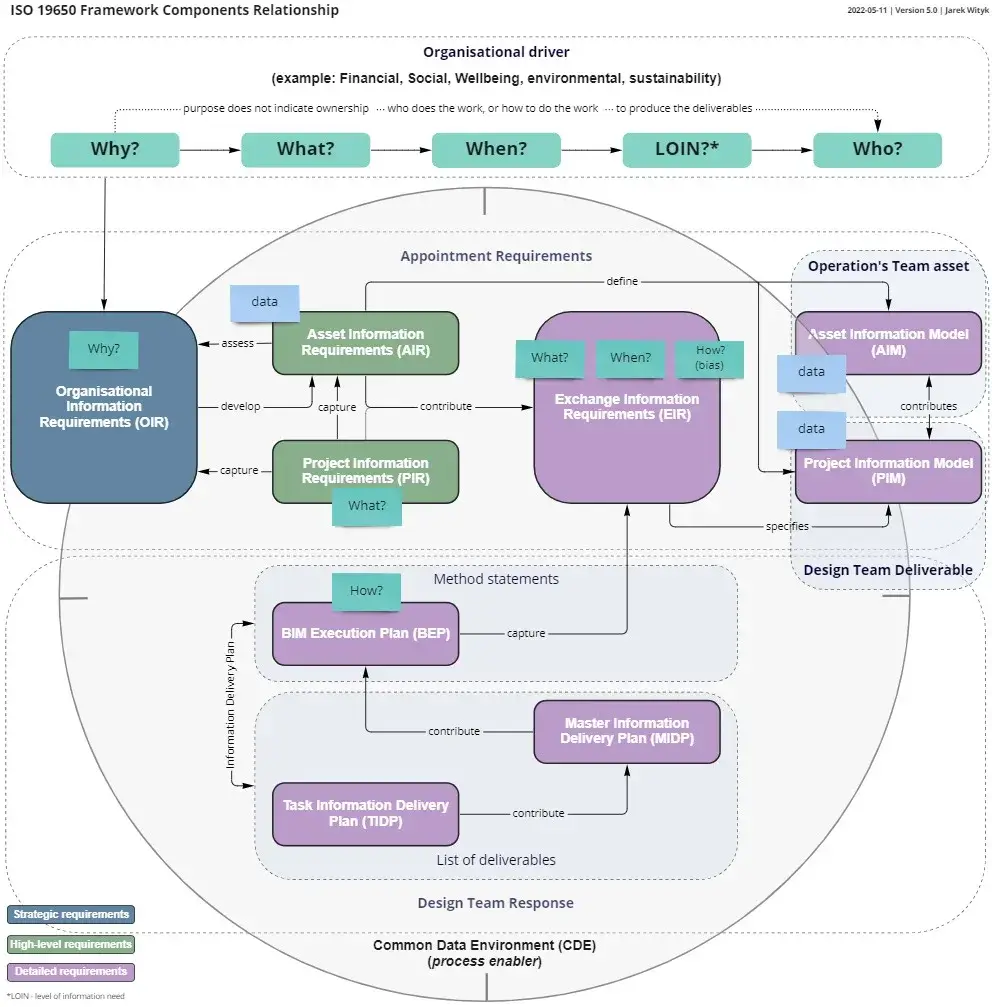- Created:
- Jarek Wityk
- Category: Dictionary, Level of, Management, Organization of information
- Updated: 2025-02-18
BIM Stages
Revit Guides
Data Management
ELI5-S1:BIM Basics: E13_Understanding BIM Stages
Understanding BIM Stages: Transitioning from BIM Levels to a Modern Framework
In the world of Building Information Modeling (BIM), we often come across terms like BIM Levels and BIM Stages. While BIM Levels have been the foundation for many professionals, the industry is gradually shifting towards the more comprehensive framework of BIM Stages as defined by ISO 19650. This post aims to explain why this transition is happening and what benefits it brings to the table.
Why Are BIM Levels Still Used?
Despite the advent of ISO 19650, many professionals still rely on BIM Levels. Here’s why:
-
Perceived Simplicity:
- Familiarity: BIM Levels are a well-known framework. Professionals have been trained to use them, making them a familiar and comfortable choice.
- Clarity: The levels offer a clear, step-by-step progression that is easy to understand and communicate.
-
Resistance to Change:
- Comfort Zone: Professionals often prefer sticking to familiar concepts rather than adopting new standards and processes.
- Fear of Complexity: The ISO 19650 stages and concepts may seem more complex and abstract, deterring some from making the switch.
-
Incremental Adoption:
- Manageable Steps: The levels offer a sense of manageable steps toward improvement, which can be less daunting than a holistic approach.
-
Success and Recognition:
- Benchmarking: Achieving a certain BIM Level is often seen as a significant milestone, providing a sense of accomplishment and recognition.
-
Legacy Systems:
- Existing Projects: Many ongoing projects and contracts were initiated under the BIM Levels framework, making it practical to continue using the same terminology.
-
Perceived Practicality:
- Direct Application: BIM Levels are directly related to the technology and processes used daily, making them feel more practical and immediately applicable.
Introducing BIM Stages: The ISO 19650 Approach
ISO 19650 introduces a new way of looking at BIM maturity, breaking it down into stages that reflect a more nuanced and integrated approach to information management. Let’s take a closer look at these stages:
-
Stage 1: Initial Information Management
- Characteristics: This stage involves laying the groundwork with basic national standards. It sets the foundation for structured information management.
- Application: Early-stage projects and organizations can use Stage 1 to establish fundamental practices.
-
Stage 2: Managed Information Management
- Characteristics: At this stage, the focus is on enhancing management with structured processes and adherence to ISO 19650-2.
- Application: This is where a mixture of manual and automated information management processes are used to generate a federated information model. It’s the main application of the ISO 19650 series, offering a balanced approach to data handling and collaboration.
-
Stage 3: Advanced Information Management
- Characteristics: The final stage involves achieving full digital integration and advanced information systems. It represents the pinnacle of BIM maturity.
- Application: Organizations at this stage have sophisticated, fully integrated digital processes, enabling seamless collaboration and data management.
The Benefits of Transitioning to BIM Stages
While BIM Levels provide a clear framework, the flexibility and integration offered by BIM Stages are designed to meet the evolving needs of modern projects. Here are some key benefits:
- Flexibility: BIM Stages are adaptable to various project requirements and scales, providing a more tailored approach.
- Integration: Enhanced teamwork and cohesive data sharing are facilitated through improved collaboration tools and practices.
- Long-term Benefits: Adopting BIM Stages helps in realizing the full potential of BIM by aligning processes with the latest standards and technologies, ultimately leading to better project outcomes.
Conclusion
The transition from BIM Levels to BIM Stages represents a significant shift in how we approach information management in the construction industry. While the familiar framework of BIM Levels has served us well, embracing BIM Stages can lead to greater flexibility, improved collaboration, and more efficient project management.
By understanding and adopting BIM Stages, professionals can stay ahead of the curve, ensuring their projects are managed with the highest standards of information management and digital integration.



2 responses
You have a great website and information
Preetam, thank you very much for your comment